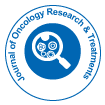Identifying a Rare and Severe Vascular Angiosarcoma Tumour
Received: 28-Apr-2023 / Manuscript No. AOT-23-101241 / Editor assigned: 01-May-2023 / PreQC No. AOT-23-101241 (PQ) / Reviewed: 15-May-2023 / QC No. AOT-23-101241 / Revised: 22-May-2023 / Manuscript No. AOT-23-101241 (R) / Published Date: 29-May-2023 DOI: 10.4172/aot.1000227
Description
Angiosarcoma is a rare and aggressive type of cancer that originates from the lining of blood vessels or lymphatic vessels. It is a subtype of sarcoma, a malignant tumor of connective tissues, and accounts for only a small percentage of all soft tissue sarcomas. Angiosarcoma can occur in various parts of the body, including the skin, soft tissues, and internal organs [1]. This essay aims to provide a comprehensive overview of angiosarcoma, including its causes, risk factors, clinical presentation, diagnosis, treatment options, and prognosis.
The prognosis of angiosarcoma is generally poor due to its nature and high propensity for metastasis. The exact cause of angiosarcoma remains unknown in most cases. However, certain risk factors have been identified, such as exposure to radiation, chronic lymphedema (swelling caused by the accumulation of lymphatic fluid), and certain genetic conditions, including Klippel-Trenaunay syndrome and Stewart-Treves syndrome. Radiation-induced angiosarcoma typically occurs several years after radiation therapy for other cancers, such as breast or lymphoma. While most cases of angiosarcoma are sporadic, some may have a hereditary component. Angiosarcoma can affect individuals of any age group, although it tends to be more common in older adults [2,3]. The clinical presentation of angiosarcoma varies depending on its location. Cutaneous angiosarcoma is the most common subtype, typically presenting as a bruise-like lesion on the head and neck, particularly in sun-exposed areas. This form of angiosarcoma is often misdiagnosed initially, leading to delayed treatment [4-6]. Other subtypes of angiosarcoma can manifest as deep-seated masses in soft tissues or as tumors in organs such as the liver, spleen, and breast. Diagnosing angiosarcoma requires a combination of clinical evaluation, imaging studies, and biopsy [7-9]. However, definitive diagnosis is made through a biopsy, which involves taking a sample of the tumor tissue for microscopic examination by a pathologist. Treatment options for angiosarcoma depend on various factors, including the location, size, and stage of the tumor, as well as the overall health of the patient. Surgical resection is the primary treatment modality and aims to remove the tumor with adequate margins to minimize the risk of recurrence [10]. However, due to angiosarcoma and its tendency to invade surrounding tissues, achieving clear margins can be challenging. In cases where complete surgical resection is not feasible, other treatment modalities may be considered.
Conclusion
Radiation therapy plays a significant role in the management of angiosarcoma, particularly in cases where the tumor is inoperable or to reduce the risk of local recurrence after surgery. However, as mentioned earlier, radiation therapy itself can sometimes be a risk factor for the development of angiosarcoma in the future. Chemotherapy is another option, either as an adjuvant therapy after surgery or as a primary treatment for inoperable or metastatic angiosarcoma. Several chemotherapy agents have been used, including paclitaxel, docetaxel, and doxorubicin, although response rates vary. Targeted therapies and immunotherapies are emerging as potential treatment options for angiosarcoma. These therapies aim to specifically target certain molecular abnormalities or stimulate the body's immune system to recognize and attack cancer cells. These innovative methods are part of ongoing clinical studies that show potential for bettering angiosarcoma patient outcomes.
References
- Shapiro JA, Gaonkar KS, Spielman SJ, Savonen CL, Bethell CJ, et al. (2022) OpenPBTA: The Open Pediatric Brain Tumor Atlas. Cell Genomics.
- Guan X, Lu Y, Zhang Y, Zhan P, Chen Z, et al. (2023) Tumor-associated NK cells facilitate tumor growth via NKp46 in immunocompetent murine hepatocellular carcinoma. Immunol Lett 258: 8-19.
[Crossref] [Google Scholar] [PubMed]
- Li B, Liu S, Zhao B, Huang X, Zhao Z, et al. (2023) Gambogic acid inhibits tumor through blocking matrix metalloproteinases mediated-β1 activation. Phytomedicine Plus: 100456.
- Verghis NM, Brown JA, Yousef S, Aranda-Michel E, Serna-Gallegos D, et al. (2023) Long-Term Outcomes of Patients With Carotid and Aortic Body Tumors. Am J Cardiol 199:78-84.
[Crossref] [Google Scholar] [PubMed]
- Tsukamoto S, Zucchini R, Staals EL, Mavrogenis AF, Akahane M, et al. (2020) Incomplete resection increases the risk of local recurrence and negatively affects functional outcome in patients with tenosynovial giant cell tumor of the hindfoot. Foot Ankle Surg 26: 822-827.
[Crossref] [Google Scholar] [PubMed]
- Wang X, Zhang H, Chen X, Wu C, Ding K, et al. (2023) Overcoming tumor microenvironment obstacles: Current approaches for boosting nanodrug delivery. Acta Biomater.
[Crossref] [Google Scholar] [PubMed]
- Guo L, Ding J, Zhou W (2023) Harnessing bacteria for tumor therapy: Current advances and challenges. Chin Chem Lett: 108557.
- Shen Y, Jin SJ, Chen YC, Liu WH, Li YM, et al. (2023) Improving the tumor selectivity of T cell engagers by logic-gated dual tumor-targeting. Pharmacol Res 192:106781.
[Crossref] [Google Scholar] [PubMed]
- Liu J, Zhang J, Gao Y, Jiang Y, Guan Z, et al. (2023) Barrier permeation and improved nanomedicine delivery in tumor microenvironments. Cancer Lett 562: 216166.
[Crossref] [Google Scholar] [PubMed]
- Wang Y, Wang R, Li B, Huang Z, Zhao S, et al. (2023) Cancer-associated fibroblasts in the invasive tumour front promote the metastasis of oral squamous cell carcinoma through MFAP5 upregulation. Gene 876: 147504.
[Crossref] [Google Scholar] [PubMed]
Citation: Olivia M (2023) Identifying a Rare and Severe Vascular Angiosarcoma Tumour. J Oncol Res Treat. 8:227. DOI: 10.4172/aot.1000227
Copyright: © 2023 Olivia M. This is an open-access article distributed under the terms of the Creative Commons Attribution License, which permits unrestricted use, distribution, and reproduction in any medium, provided the original author and source are credited.
Share This Article
Open Access Journals
Article Tools
Article Usage
- Total views: 1252
- [From(publication date): 0-2023 - Apr 02, 2025]
- Breakdown by view type
- HTML page views: 1029
- PDF downloads: 223
